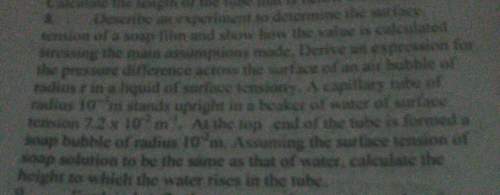
Physics, 17.10.2019 01:20 Robinlynn228
Assume you want to deduce the radius of a solar system planet as it occults a background star when the relative velocity between the planet and earth is 30 km/s. if the star crosses through the middle of the planet and disappears for 26 minutes, what is the planet’s radius?

Answers: 2


Another question on Physics

Physics, 21.06.2019 22:30
The membrane surrounding a living cell consists of an inner and an outer wall that are separated by a small space. assume that the membrane acts like a parallel plate capacitor in which the effective charge density on the inner and outer walls has a magnitude of 7.0 × 10-6 c/m2. (a) what is the magnitude of the electric field within the cell membrane? (b) find the magnitude of the electric force that would be exerted on a potassium ion (k+; charge = +e) placed inside the membrane.
Answers: 1

Physics, 22.06.2019 13:40
Use the profile illustrated for problem (1). assume that the layer of silty sand fill (sm) is placed over the entire site. estimate the thickness of the fill (h - in feet) that will cause the effective vertical stress at the center of the clay layer to increase by 517.5 pounds per square foot.
Answers: 1

Physics, 22.06.2019 16:30
He latent heat of vaporization for ethyl alcohol is 854 j/g. the amount of energy, rounded to the nearest whole number, needed to change 5.20 grams of ethyl alcohol from a liquid to a gas is
Answers: 2

Physics, 23.06.2019 02:10
Find the steady-state temperature at the center of the plate = /2, = /2) for sums of w from n=1 to n=19 (only odd values). find the value of n for which the change in /2, /2) is less than 1% from the value at the previous n. at this point, we consider the solution converged. does the value of the temperature at the center seem reasonable? in this part, the values of x and y are constant scalar values. you should produce a plot of the value of n on the horizontal and the estimate of the temperature at the center of the plate on the vertical. b. using the value of n (or larger) that resulted in convergence in part (a), create a contourf plot of the temperature distribution across the entire plate. use enough spatial subdivisions to create a useful plot. comment on the results. hint: you need to determine what “x” and “y” values to use to make your t matrix. i recommend using a different number of x and y values. use enough x and y values so that the plot is “smooth”.
Answers: 1
You know the right answer?
Assume you want to deduce the radius of a solar system planet as it occults a background star when t...
Questions



Health, 13.04.2020 23:57



Business, 13.04.2020 23:57

Biology, 13.04.2020 23:57



Chemistry, 13.04.2020 23:57


Spanish, 13.04.2020 23:57


Mathematics, 13.04.2020 23:57


Mathematics, 13.04.2020 23:57

Social Studies, 13.04.2020 23:57


Chemistry, 13.04.2020 23:57




